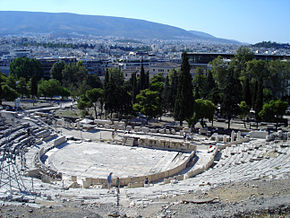Example of a Greek trireme.
In ancient
Greek culture, the arts were important. So important in fact, that when the
very rich were taxed, they were given the choice of outfitting a trireme or
putting on a tragedy. While most of
today’s plays are no longer performed during the day at the theater of Dionysus,
some of the original Greek elements are kept in the theater. For example, the term
thespian, which actors are still called today, originated with the man Thespis, who basically created the
concept of an actor by separating a single character out of the chorus. Even truer to the origins of ancient Greek theater are
modern performances of ancient Greek plays. I had the opportunity to attend one
of said plays recently, Hecuba by Euripides, which was performed by the Westminster
College in BYU’s De Jong Concert Hall. The play both kept to, and strayed from,
Greek theater traditions, providing an interesting dichotomy that I will
describe as follows:
Masks
Example of a mask that might be used in a Greek tragedy.
In
ancient Greece, the actors in their tragedies would wear masks to denote the
characteristics of the figure they were portraying. This allowed the actors to
easily play multiple rolls, and given that only men were allowed to act in (or
view) the tragedies, it allowed the male actors to more easily portray female
characters. The masks also helped to amplify the actor’s voices. In the
rendition of Hecuba that I witnessed, female actors were utilized, as well as
microphones, and no masks were present, although the costumes used to portray
the people in that time period seemed very realistic to my amateur aesthetics.
Chorus
What a chorus in ancient Greece might have looked like.
A large
part of Greek tragedies are the chorus, a group of actors, likely with a chorus
leader to speak the singular words, who sang and danced to provide interaction
with the main characters and provide more entertainment to the audience. In
Hecuba, the director chose to set the chorus parts more as individual lines
from the females in it, and the words were more spoken then sung. I believe
that separating out the lines better allowed the women to be portrayed as
individuals, showing the quieter grief, or thoughts, of the newly enslaved
women who lived with Hecuba in Troy.
Music
Depiction of chorus with their instruments.
Music
was a large part of Greek tragedies- the word tragedy itself come from the
Greek word tragoedia, which means “goat
song”, to represent the songs of the satyrs that followed Dionysus. It’s likely
that music was played along with the songs of the chorus, and in the portrayal
of Hecuba that I witnessed the choral odes where accompanied by recorded music,
although the instruments weren't carried by the chorus members as they would
have been in Greece.
Religious Ritual
The sacrifice of Polyxena by the Greeks, ca 570-550 BC
During
the play the Gods were often referenced, and the actors often knelt in the
position of a suppliant that actors or citizens of Greece would have taken when
begging or asking for a favor as the characters in the play often did. One of
the most symbolic symbols to the religion of the Greeks was, when referencing Zeus
and his day, the actors on several occasions threw up their arms as if to marvel at the sunlight on them. Also important to their religion was the concept of a blood sacrifice. Normally animals would be slaughtered to the Gods, but in the play Hecuba's daughter, Polyxena was sacrificed over the grave of the Greek warrior Achilles, who's ghost had appeared before the army demanding a prize to glorify his actions in war.
Theater Settings
Theater of Dionysus in Athens
A major
difference between the play I witnessed and that that would have happened in
Athens is how the theater was set up. In Greece the audience would have been in
a half circle around the stadium seating, likely all male, and seated by tribe.
My seating was general admission. Additionally, the play was performed in the
evening, inside, which was not how the Greeks performed. There were some
similarities however. The acting all happened in a single day, any offstage
happenings just reported by actors, and all occurred in one setting as it would
have in Greece. Additionally the set was very simple, just some draped cloths
to represent the tents, which was how the Greeks likely performed.
Expressions of Grief
Hecuba and Polyxena, Westminster College 2014
Culturally,
American’s have several cultural difference to the ancient Greeks, including
our expression of grief. While the actors beat at their breasts and mentioned
tearing at the skin like they would have in Greece, when expressing their grief
they took artistic license and grieved in a way the audience could understand
instead of the stage directed Greek sounds of grief. Before the play, during a lecture about the concept of Greek theater, the professor educating us performed several of the expression of grief in the stage directions, which sounded comical to our westernized ears. As such, to better portray the emotion to the intended audience, more modern expressions of grief, like gasps or sobbing were performed by the actors.
Playbill for Hecuba, Westminster College 2014
Overall, while sad, watching the play Hecuba was an experience
worth having. It’s very interesting to compare knowledge we have of Ancient
Greece with how it is portrayed today, in the performance of the products of
their mind and culture, which in this case was expressed through a tragedy.
While the venue was very different the emotions expressed cross both time and cultural
difference to make you feel for those portrayed, which I believe is the most
important aspect of art.




